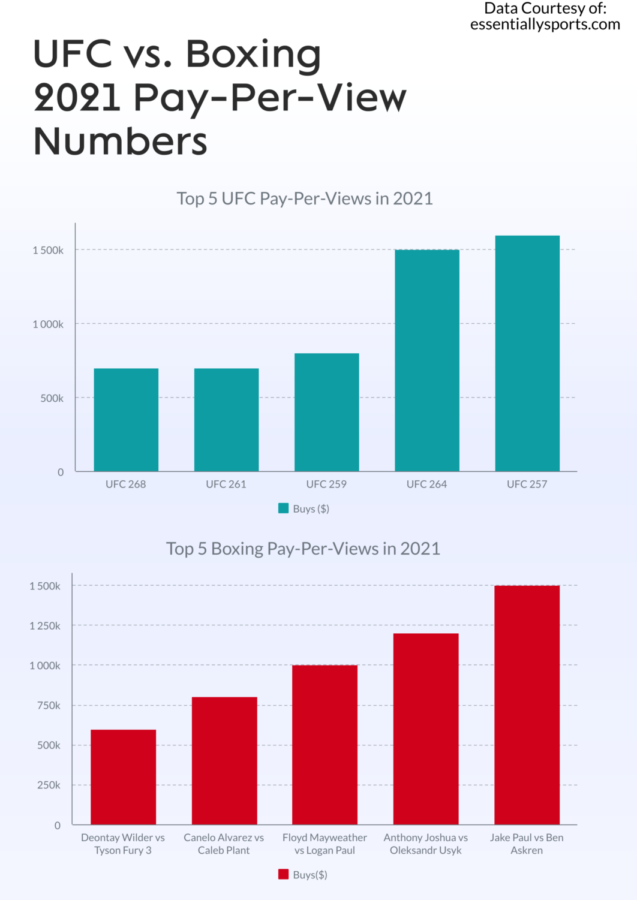MMA vs. Boxing
Comparison of Pay-Per-View numbers between UFC & Boxing in 2021.
In 2022, combat sports are seeing popularity like never before. Boxing, which has been around for decades, has brought fresh and exciting faces to the table over the past few years. MMA, however, has been on the rise over the past 20 years, truly blowing up during the pandemic.
In a 2008 ESPN segment that featured a debate between MMA enthusiast Joe Rogan and boxing promoter Lou Dibella, a question was raised: “MMA or Boxing”?
Is one safer than the other? Is one more exciting? Which sport requires greater athletic ability? Broadly put, these questions are not that simple to answer.
These two sports are far from similar. Boxing requires the movement of a portion of the body, with a focus on the arms for punching an opponent. In contrast, MMA requires an athlete to use literally every part of their body from their head all the way to their toes.
If you think about it, boxing is a very basic form of combat, restricting the use of legs. MMA is the epitome of fighting, incorporating wrestling, boxing and martial arts ranging from karate, kung fu, taekwondo, etc.
It can be argued that boxing is the safer sport given that there is no worry of potentially being kicked, elbowed or kneed in the head, but are those options worse than being constantly hit in the head, with 10-ounce gloves, over the course of 12 three minute rounds?
According to a 2016 study published in the Clinical Journal of Sports Medicine, “MMA fighters experience more minor contusion/bruising injuries while boxers are more likely to experience serious injuries such as concussion/head trauma involving loss of consciousness or eye injury such as retinal detachment.”
This is somewhat hard to believe as boxers are less likely to experience injury during a match. MMA fighters rarely walk out of the octagon without a cut, bruise or dropping a little bit of blood.
These were some of the very points brought up by Rogan and Dibella in the heated 2008 debate, but the question still remains “Which one is better?”
After watching MMA consistently since the pandemic started, I can safely say that MMA is the more exciting sport. It has every element of combat you can ask for, performed by the highest level of athletes.
When first watching, the grappling/wrestling aspect was somewhat boring to me as there wasn’t much action compared to that of a traditional standup/boxing match. But after learning more about wrestling and the art of jiu-jitsu, I’ve learned to appreciate this form of martial arts, similarly to the intricacy and elegance of ballet.
MMA is strategic in the sense of mind games outside of the octagon and the physicality inside. Most fight fans, both MMA and boxing, go into matches with the hope of seeing a competitive fight that ends in a knockout.
While knockouts do occur in boxing, KOs seem to happen way more frequently in the sport of mixed martial arts due to the use of more punishing strikes consisting of knees and elbows.
One of the most important and key components of combat sports is the polarizing figures that come from these sports. Over the past few decades, there has been a small percent of boxers who have caught the attention of mainstream media – whether for better or worse.
Connor McGregor for instance is just one of the many fighters who has made national headlines coming out of the MMA world. The most important part of McGregor and his personality is not only the fact that he was once a great fighter but the fact that he’s a true performer.
For years, fans across sports-tuned in to see the former lightweight champion compete, not because they wanted to see him win or lose but to purely see him entertain.
Boxing cannot say the same, as the greatest generation of boxers fought numerous decades ago. No modern boxer has really drawn eyes to the sport of boxing.
The entertainment factor from the athletes to the sport itself is the true reason why MMA is on the rise and is slowly surpassing boxing as the bar on the combat sports hierarchy.






